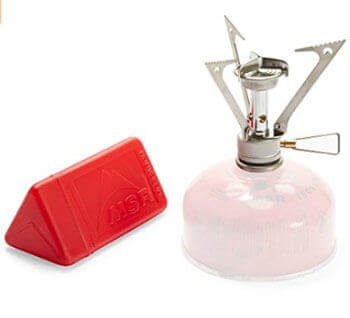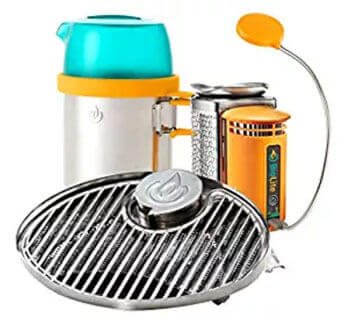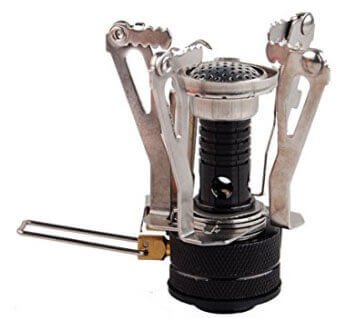The best backpacking stoves are lightweight, easy to use and do not take up too much space. Check our guide out below.
There may be something endearing about the idea of ‘living off the land’ while backpacking, surviving on our wits alone and the fruits and berries available in the wild, but unless you’re an expert there’s every chance that you’ll end up hungry at best, and doubled over with a stomach upset at worst.
To this end, an investment in a lightweight camping stove is an essential for any hiker – few things are more enjoyable that pitching up a camp and firing up a barbeque to roast some sausages, beans or a one-pot feast.
This guide will talk you through what to look for in the ideal camping stove, and of course, recommendations of particular models that we value highly.
Top 5
MSR PocketRocket Stove

As the name may suggest, the MSR PocketRocket is one of the smallest and lightest Canister stoves available to hikers, but size isn’t everything; despite weighing less than 5oz, this product packs quite a punch.
Burning for an hour at a time and boiling water in a little over three minutes, and for something so miniscule it can withstand some serious elemental impact from string winds and the like.
It’s really difficult to find a reason not to recommend the MSR PocketRocket if you are new to game of hiking and don’t require any bells and whistles on your portable stove; it’s the perfect combination of lightweight, portable and effective.
PROS – So simple to carry without any kind of weight on your back, boils water up pretty quickly, usable straight from the box and cheaper than a great many supposedly superior products.
CONS – Very few, especially for such a low price point. It’s not the sturdiest stove that you can get your hands on, as it to be expected for something so cost-effective and lightweight if you plan on using it regularly, and be careful of imitations when shopping online – MSR is an extremely popular brand, and thus are ripe for exploitation.
JetBoil MiniMo Personal Cooking System

One of the most reliable Canister Stoves on the market, the JetBoil MiniMo is much more advanced than a typical stove of this ilk, packed with features (though admittedly a price tag to match).
Using this stove whilst hiking will allow you to boil water in no time at all for those quick coffee pit stops, alongside simmer control for those that wish to bring a gourmet chef experience to their outdoor cooking and a built-in pot that’s easy to prepare your food within (there’s also a smaller model named the MircoMo).
PROS – Available in a range of colors, so simple to use that it’s almost insulting, and extremely fast when it comes to boiling water. The simmer control is also a nice touch.
CONS – The JetBoil is lightweight, but some hikers may find the shape to be a little bulky to carry. It’s expensive for a Canister Stove, especially seeing as the igniter on these models tends to be slightly less reliable than somebody making such a substantial investment may be comfortable with.
MSR Dragonfly Stove

Back to MSR, and now we’re recommending a Liquid Fuel Stove. The Dragonfly is one of the most versatile camping stoves available, able to run from a variety of liquid sources including white gas, kerosene and diesel – wherever you are in the world, you’ll be able to get this beauty running.
It’s incredibly sturdy, but without sacrificing portability – you can fold this stove up to around a third of its full size while on the move – and the performance is quite brilliant. The Dragonfly has numerous settings and unparalleled flame control, so if you’re serious about your outdoor cooking you’ll have a whale of a time getting things just so. Sure, it’s costly but sometimes you get what you pay for.
PROS – A variety of efficient fuel sources and the ability to shrink down to a tiny size make this the perfect stove for international travelers – no matter where you are in the world you can rest assured that you’ll be able to make use of this high quality piece of kit.
CONS – The Dragonfly is loud. That may not sound like a big deal on paper, but if you’re in a shared campsite, are on a hunting trip that involves keeping your presence stealthy or simply want to relax while brewing up a cup of Joe and a tin of beans, that can get frustrating.
BioLite CampStove Bundle

And now, onto the finest Wood Burning Stove that money can buy – and lordy, does your money buy you a lot with this model. A grill, pot, kettle, lamp and cell phone charger in one, this is truly everything you’ll find in your kitchen bar the sink, all run from small items that can be found around a campsite such as pine cones and small pieces of wood.
The BioLite CampStove works quickly, does not emit any smoke or noise, and tucks into itself to be carried with a simple handle. Throw in the aesthetically-pleasing modern design and you have a truly cutting edge item.
PROS – Smoke-free, charges electrical appliances, comes complete with a lamp, the option to grill food as well as boil and cook in a pot… what’s not to love!
CONS – It is quite a chunk of change, regardless of how much this stove has to offer. All these features also add a little bit of weight – not much, granted, but enough to notice.
Ultralight Backpacking Canister Camp Stove with Piezo Ignition

From one extreme the other, let’s conclude our guide with the simplest and cheapest Canister Stove that anybody could wish for.
Roughly the size and weight of a packet of cigarettes you’ll struggle to find a more portable stove than this model, and it boils up water in around three minutes.
The selling point is really the price tag here, which is very cheap, making it a perfect option for single use – especially as it lives up to its lightweight moniker.
PROS – For something so cheap, this is an impressive piece of kit – the flame is sturdy and largely high, it works quickly, and it’s so light that you will barely even notice that you’re carrying it.
CONS – At the end of the day, this is a cheap model and cheap models are not built to last – you will get one, maybe even two or three, happy uses out this stove, but it’s hardly an item that will see you through an entire summer. If you’re planning anything longer than an overnight stay, look at the PocketRocket.
Buyers Guide to Camping Stoves
Is there any such thing as the perfect backpacking stove? Many experienced hikers will mix and match a variety of different items to suit their needs through trial and error.
However, if you’re just starting out on the adventure lifestyle this guide will help you decide how to proceed.
3 Types of Camping Stove
There are three primary types of camping stove available.
The most popular is the traditional Canister Stove, which is simple to run and with little maintenance and draws power from easily sourced fuel sources such as isobutane and propane.
Liquid Fuel Stoves are a little more versatile, able to be connected to refillable bottles and drawing their fuel from a variety of sources – most typically white gas, but your options are open should you find yourself in an area with no access to a supply.
Finally, Alternative Fuel Stoves are comparatively new but gaining in popularity, especially with environmentally conscious campers, thanks to their ability to run from wood.
Canister Stove: Ideal Starter Model
Canister Stoves are the perfect starter model, and ideal for anybody planning an overnight or otherwise short stay outdoors.
This is because Canister Stoves essentially come fully-formed from the box, with the canister containing everything you need to get your meal prepared with one quick action of lighting – no need to fuel up, just flick a switch and take a match or lighter to the stove.
Drawing fuel from the canister typically ensures a regular and steady flow of heat, and even if you have a clumsy moment and knock the stove over, you won’t spill anything and risk a forest fire.
The downside of these basic models is they may not operate quite as strongly in cold or windy conditions, you won’t have any idea about how much fuel you have left which means that you may run out halfway through preparing a feast, and you’ll have to dispose the canister in an environmentally-conscious manner – if you don’t have a recycling center nearby, you may find this something of an inconvenience.
Liquid Fuel Stove
Liquid Fuel Stoves are often even smaller (making them perfect for international adventures), and the white gas used to power them is typically readily available and extremely cost-effective.
They operate powerfully whatever the weather, the use of everyday clear bottles such as a water container mean that there’s nothing to dispose afterward and you’ll be able to keep an eye on how much you have left before you’ll need to refill.
Of course, every positive has a negative – in the case of Liquid Fuel Stoves, it’s the amount of maintenance they require.
You’ll have to continually clean the device, and possibly replace small parts, as well as pump the fuel container to keep a steady supply of gas running into the stove. They’re also a little costlier, and you may find yourself spilling fuel.
Wood Burning Stove
Wood Burning, or Alternative Fuel, Stoves come in a variety of different weights and sizes, depending on which materials are used to create the device.
A little more technologically advanced than Canister or Liquid Stoves, you may be able to use an Alternative Fuel Stove to generate electricity that you can use to charge a cell phone or camera, while you may even be able to find a model that contains a separate grill.
This is all great, although be aware that many locations will prevent the use of fire, thus rendering the stove useless – and good luck finding a dry supply of wood if you’re camping during any kind of rainy season.
You can purchase pellets to use as fuel, but will you really want to carry something else around with you?
Logistics
Once you have decided which type of stove you think will suit your needs best, you will of course need to think about logistics.
You’ll want the lightest possible model that does not sacrifice sturdiness, and something in a convenient shape.
A camping stove alone will not host your dinner, so you’ll need to bear in mind the pots and pans that you plan on placing upon your stove – will the materials and dimensions of your utensils match up with the item that you have your eye on?
Of course, there is also the small matter of price points – like anything, camping stoves vary wildly from cheap and cheerful to expensive luxury. Above you will find details of five different highly regarded models and the best backpacking stoves of different formats that should cater for any requirement.
